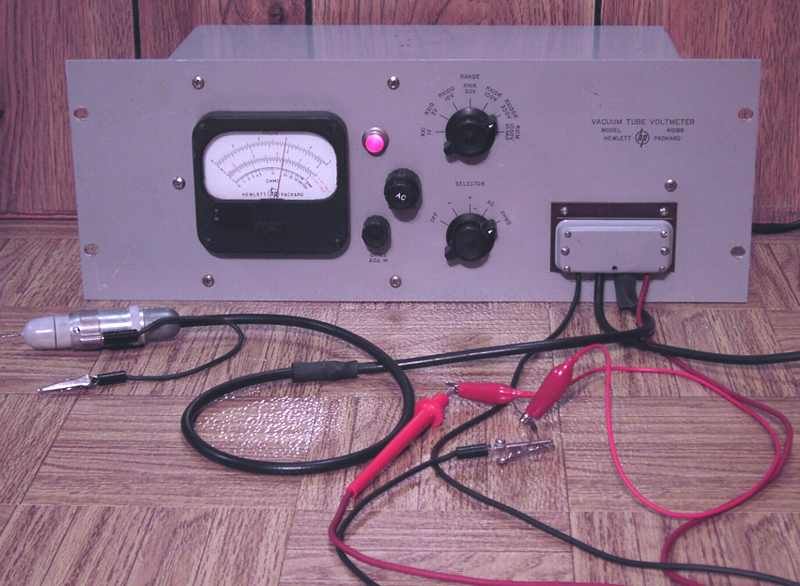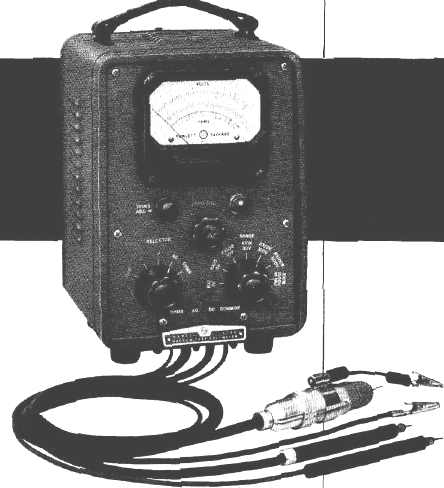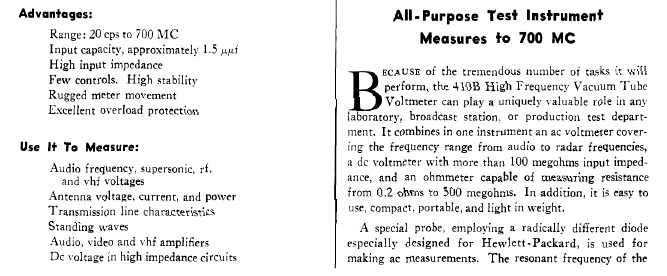
Having repaired several other Hewlett-Packard Vacuum Tube Volt Meters (VTVM) that measure AC only at a frequency of up to 2 or 4 MHz, I was eager to see how this model stacked up. The laboratory grade HP-410B is one of the best VTVMs ever made. It can measure AC voltages with a frequency response to 700 MHz within 1 dB. It is useful to around 3 GHz according to the manual. That makes it excellent for measuring radio frequency voltages. It can also measure DC with an input impedance of 122 megohms on all ranges. Resistance can be measured from 0.2 ohms to 500 megohms.

That warm probe
This 410B uses a special Eimac tube within the probe, the 2-01C diode. It operates at 5 volts AC. Its filament is voltage regulated by a ballast tube. The 410B may also have been supplied with an Amperex EA53 in the probe in place of the 2-01C. The EA53 filament requires 6.3 volts rms. The 410B also uses a 6X4 rectifier, a 6-4 filament regulator, a 0B2 regulator, and a pair of 12AU7 for DC voltage amplifier and meter bridge. There are no batteries in this VTVM. The set's internal regulated voltage and a low-voltage solid state rectifier supply DC for the ohms function in place of the battery typically found in general-purpose VTVMs. This particular piece is the rack mount version, model 410BR. The more typical and portable version of the 410B shown in the catalog ad below has a cabinet style similar to the HP-400D AC VTVM and the HP-200CD audio oscillator .


The 410B was introduced in an article titled, The 700 Megacycle Voltmeter and Its Applications in the November 1950 Hewlett-Packard Journal (Vol 2, No. 3). It replaced the HP-410A which was introduced in 1946. The 410B eliminated the need for a matched pair of diodes in the 410A. An upgrade module was made available for the 410A.
Price of the HP-410B in the 1952 HP catalog was $245.
The operating and service manual can be found on the BAMA site. A higher quality PDF version can also be found on the HP archive site (see links on my home page).
Repairs - fixing a cold probe
Problems with this HP-410B included poor accuracy on DC and totally inoperative AC measurement.
After safety checks and a slow power up, I noticed that the probe did NOT get warm. That would explain the totally inoperative AC measurement function. Could it be the 2-01C tube itself? I opened the probe, pulled the tube and found the filament to be good, much to my relief. I also found just a quarter volt or so of AC between probe ground and the filament terminal of the 2-01C socket. Next check was the ballast tube and the voltage adjust rheostat. The ballast tube was running rather hot. Conclusion; short circuit in the filament line. Further checks showed the short to be at or in the probe cable.
I disconnected the sealed cable and probe assembly from the VTVM and used an external 12 volt power supply and 3 amp car headlight load to try to determine which end of the cable might be the problem. (I measured the voltage drop with a digital meter with power applied at either end of the cable. The side with the least voltage drop would be closer to the short circuit.) The voltage drop comparisons showed just a small difference between the two measurements suggesting the short was closer to the VTVM end than the probe end. I could see some wear at the VTVM end of the cable. The cable is double shielded coaxial with a fixed plastic terminator for the connection to the VTVM and the sealed probe assembly on the other end. The cable is sealed into both the probe and the plastic terminator making replacement not an easy task.
The inner shield is connected to the chassis ground and the outer shield carries the 5 volts of filament. The short circuit was between those two shields. I decided to skin a small section of the cable at the wear point next to the VTVM cable clamp and cut the outer shield to see if the short could be located. No luck. The short was further down the cable. At this point I noticed a small kink in the cable about one third of the way to the probe. Could it be the location of the short? I again skinned the insulation, carefully cut the outer shield and found the short right at the kink. The cable had apparently been severely pinched leaving the kink and damaging the insulation between the inner and outer shield. I skinned enough of the cable outer insulation and outer shield to fully expose any damage. Then taped the inner insulation, pulled the outer shield back over the tape, wrapped a bit of shield from another cable around the cut shield and soldered the pieces together. Heat shrink tubing over the outer shield completed the repair.
Adjusting for calibration.
The poor accuracy on DC was solved by recalibration. I suspect the adjustment was tampered with in an attempt to fix the AC probe problem.
The HP-410B has a number of screwdriver adjustable calibration potentiometers, one for all of the DC ranges together and one for each of the AC ranges. I have a high-precision DC meter that is accurate to 1/4 % and used that as the reference for adjusting the DC scales.
For the AC adjustments, I used an isolated variable AC source and a known accurate reference meter to tweak each of the ranges. The accuracy of the HP-410B is rated at 3% of scale. While that may not be an extreme accuracy, the value of the 410B is measurement at very high frequencies where many digital meters fall short and also at very high impedance when measuring DC. Calibration can be accomplished at power line frequency and remain accurate for very high frequencies.
Special uses
I plan on using the 410B for voltage measurement at radio frequencies, for low and very high resistance readings and for measuring DC with very minimal loading such as required for vacuum tube AVC circuits. The 410B excels for all those measurement needs and is a worthy addition to the test bench.
List of other HP pieces I have repaired
Here is an
index to my other HP projects.
date 7-08
A Poly-Comm 6 Transceiver was the previous item on the bench.